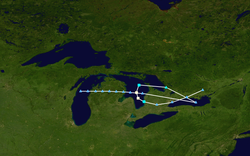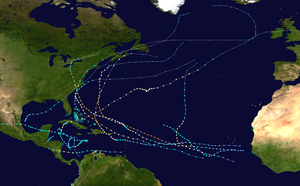1996 Lake Huron cyclone
The 1996 Lake Huron cyclone was a strong cyclonic storm system that developed over Lake Huron in September 1996. The system resembled a subtropical cyclone at its peak, having some characteristics of a tropical cyclone.[1] It was the first time such a storm has ever been recorded over the Great Lakes region.[2]
 "Hurricane Huron" at peak intensity on September 14. | |
| Type | Subtropical cyclone |
|---|---|
| Formed | September 11, 1996 |
| Dissipated | September 15, 1996 |
| Lowest pressure | 992 mb (29.29 inHg) |
| Highest winds | |
| Damage | Unknown (flooding) |
| Casualties | None |
| Areas affected | Great Lakes region, Northeastern United States, Eastern Canada |
Overview of tropical storms in the Great Lakes region
The Great Lakes region has experienced the remnants of several hurricanes, most commonly those which originally made U.S. landfall along the Gulf of Mexico.[3] Very few such storms retain any tropical characteristics by the time they reached the Great Lakes. In general, the strongest of these storms result from interactions between a hurricane remnant and a frontal weather system. Only two such storms had hurricane-force winds over the Great Lakes.
After merging with a strong cold front, the remnant of the 1941 Texas hurricane had hurricane-force winds over Lake Huron and Lake Ontario, with steady winds of 56 miles per hour (90 km/h) reported over Detroit.[3] Half of the resulting deaths occurred in Toronto, and many injuries resulted from windows blown out in Detroit.[3][4] Although the center of the storm was tracked over Chicago and other highly populated areas, no other inland region reported similar damage. Similar to the 1996 Lake Huron cyclone, the 1941 hurricane tracked over the Great Lakes in September, when the lakes are at their warmest.[3]
Hurricane Hazel entered the Great Lakes region as an extratropical storm just west of Toronto. The storm had lost most of its intensity after tracking over 600 miles inland. However, the remnant interacted with a trough just south of Lake Erie, resulting in explosive strengthening as it entered the Great Lakes region.[5] Hurricane Hazel was an October storm with equivalent to Category 1 winds by the time it reached Canada, but most of its damage was caused by extreme rainfall on already saturated ground.[5]
In contrast, the 1996 Lake Huron cyclone developed tropical characteristics over the Great Lakes region completely independent of precursor tropical cyclone. This makes it unique among Great Lakes storms.
Meteorological history

On September 11, 1996, a weak low-pressure area was situated close to Lake Superior,[6] as well as a shortwave trough over Ontario. Its surface central pressure over Lake Michigan was 1012 millibars (29.9 inHg). The northwest tilt of the low indicated that the surface center was strengthening due to baroclinic forcing. In addition to this, analyses of the atmosphere concluded that the cyclone extended into the upper troposphere.[6]
The cyclone's overall strength increased dramatically while meandering over the Great Lakes, with surface winds building from 11 mph (18 km/h) to 67 mph (108 km/h).[6] By September 12, the cyclone had been steered by a cold front to a position over Lake Huron, with the upper-level circulation centered to the west over Michigan. During this 24-hour period, the cyclone's central pressure fell from 1012 millibars (29.9 inHg) to 1006 millibars (29.7 inHg). After 12:00 UTC on September 12, the low moved southeastward and became more vertically organized.[6]
For a brief time, the cyclone moved southeastward over Lake Huron. The greatest intensification occurred at lower levels. As the cyclone's component layers were well-stacked, the storm was ripe for development. Eventually, the cold front to the north, which was connected to the surface low, became an occluded front as it entangled with the surface warm front. The occluded front extended from Lake Huron to Pennsylvania on September 13. A 155-mile (250 km) swath of showers and thunderstorms was positioned across the area. More showers were centered near the occluded low.[6]
Between 12:00 UTC on September 13 and 00:00 UTC on September 14, a shortwave trough rotated throughout the area of the occluded front. This caused the mid-level portion of the cyclone to move eastward, centering itself just east of Lake Huron.[6] During the same period, the surface circulation moved slowly over Lake Huron and deepened to 999 millibars (29.5 inHg). In response to this intensification, the maximum sustained winds increased as well. After 00:00 UTC September 14, the lower-level and mid-level circulations of the cyclone moved westward, becoming vertically organized again. In contrast to the earlier developments, the baroclinic processes of the system weakened rapidly, and the system became more shallow. However, the lower-level circulation continued to intensify, dropping to 993 millibars (29.3 inHg),[6] due to increased circulation. At the time of its peak intensity, the cyclone had maximum sustained winds of 73 miles per hour (117 km/h), equivalent to that of a powerful tropical storm.[7]
Between 12:00 UTC on September 14 and 00:00 UTC on September 15, visible satellite imagery of the vortex revealed a resemblance to a tropical cyclone, with an eye-like feature about 19 miles (30 km) wide.[6] In addition to the eye, convective clouds had also formed, creating an eyewall resembling that of a tropical cyclone.[3] Furthermore, bands of convection continued extending westward about 310 miles (500 km). Soon after, winds turned to the east-northeast and rapidly increased, shearing the system. In contrast to the earlier stages of the system's life, the system was now much shallower and harbored energy closer to the surface. Surface analysis indicated that the cyclone had multiple circulations, with a weaker cyclonic circulation persisting over the eastern shore of Lake Huron and another center north of Lake Ontario.[6] During this 12-hour period, the cyclone decayed rapidly, mainly in the lower troposphere. Twelve-hour cloud height rises also occurred, ranging from 66–197 feet (20–60 m). On September 15, the cyclone weakened into a remnant low and left Lake Huron, dissipating soon afterward.[6]
Impact
Excessive rain of over 4 inches (100 mm) fell over the land surrounding the Great Lakes. This caused flooding in both the United States around Buffalo, New York and on the eastern shore of Lake Huron in Ontario.[6]
See also
- 1996 Atlantic hurricane season
- Hurricane Fran
- Subtropical cyclone
- Extratropical cyclone
- 2006 Central Pacific cyclone
- Subtropical Cyclone Katie
- 2018 Southeast Pacific subtropical cyclone
- South Atlantic tropical cyclone
- Mediterranean tropical-like cyclone
- List of storms on the Great Lakes
- List of Canada hurricanes
- Brown ocean effect
References
- Jonathan Erdman; Eric Chaney (17 November 2016). "'Hurricane Huron': The Oddest Storm to Ever Hit the Great Lakes?". Weather Underground. Retrieved 22 November 2017.
- Miner, Todd; Sousounis, Peter J.; Wallman, James; Mann, Greg (February 2000). <0223:HH>2.3.CO;2 "Hurricane Huron". Bulletin of the American Meteorological Society. 81 (2): 223–36. doi:10.1175/1520-0477(2000)081<0223:HH>2.3.CO;2.
- William R. Deedler (August 18, 2004). "Hurricanes in Michigan???". National Weather Service Detroit/Pontiac, MI. Retrieved 2020-02-08.
- Canadian Hurricane Centre (2009-09-14). "1941-2". Storm Impact Summaries. Archived from the original on 2013-04-21. Retrieved 2011-07-29.
- Peter Bowyer (2004). "Storm information". Canadian Hurricane Centre. Archived from the original on July 15, 2014. Retrieved June 17, 2009.
- Todd J. Miner (Penn State University); Peter J. Sousounis; James Wallman; Greg Mann (2000). <0223:HH>2.3.CO;2 "Hurricane Huron". Bulletin of the American Meteorological Society. AMS Online Journals. 81 (2): 223–236. Bibcode:2000BAMS...81..223M. doi:10.1175/1520-0477(2000)081<0223:HH>2.3.CO;2.
- Miland Brown (6 August 2009). "World History Blog: The Great Lakes Hurricane of 1996". Retrieved 25 August 2016.
External links
- Peter J. Sousounis; James Wallman; Greg E. Mann; Todd J. Miner (March 2001). <0401:HHAEOA>2.0.CO;2 ""Hurricane Huron": An Example of an Extreme Lake-Aggregate Effect in Autumn". Monthly Weather Review. American Meteorological Society. 129 (3): 401–419. Bibcode:2001MWRv..129..401S. doi:10.1175/1520-0493(2001)129<0401:HHAEOA>2.0.CO;2. ISSN 1520-0493.
- "WHYY Franklin Facts: Thursday September 12 – "Hurricane Huron"". 12 September 2002. Archived from the original on 2007-03-10. Retrieved 25 August 2016.
- "Hurricane Huron – September 1996". YouTube. 5 December 2009. Retrieved 25 August 2016.
- Miland Brown (6 August 2009). "World History Blog: The Great Lakes Hurricane of 1996". Retrieved 25 August 2016.
- John Taylor; Jay Larson; Sheri Voeltz (2001). "Climate Modelling at the Regional Scale" (PDF). Argonne National Laboratory. Retrieved 25 August 2016. (Paper discussing computer simulations of "Hurricane Huron").

